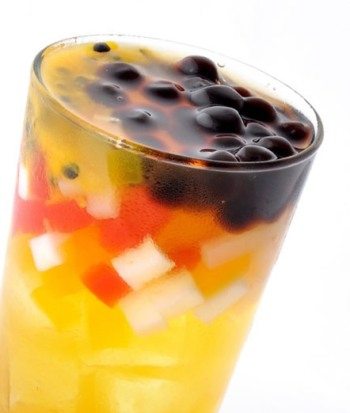Warning: Undefined array key "sharing_networks_networks_sorting" in /var/www/wp-content/plugins/monarch/monarch.php on line 3904
Warning: Trying to access array offset on value of type null in /var/www/wp-content/plugins/monarch/monarch.php on line 3904
Bubble tea, boba tea – taunting black blobs floating in a sea of milky tea – are they same or different? Did you also know that you can drink red beans and pudding with the black blobs too? And what flavor do you get: black tea, matcha green tea or passion fruit? Why are there so many options? What is this ‘Bubble Tea?’
To those not acquainted with this Asian dessert, the concept of bubble tea can be exasperating. There are so many unfamiliar flavors and random things with which you are presented. More intimidating is that you are expected to choose from names of ingredients and flavors you may never have even heard of.
“Red Moo Moo,” excuse me?
Fortunately, Downtown is well versed in the diction of bubble tea. Read on to learn about what’s up with this fandom.
First Off: What is Bubble Tea?
Bubble tea is a tea-based drink mixed with milk (or sometimes a fruit flavoring) to which tapioca pearls are added.
Grass jelly (a black plant-based jelly), lychee jelly, egg pudding and red bean can be added to the drink or as replacement to the tapioca pearls. Bubble tea is not limited to the traditional black tea with milk. The basis for the drink can range from fresh tea (such as jasmine green tea), fruit tea, coffee, smoothies, milk, and more.
As for which pairing is best, none. Pairings are relative to the person ordering the drink. However, the texture of the tidbits and density of the drink should be taken into consideration. If the basis of the beverage is thick (for example, if it is a fruit-flavored smoothie), perhaps adding thick egg pudding may not be the best option in terms texture or overall flavor. The drink may be a little sweet, but this may be the preferred option for those with a sweet tooth.
Alternatively, if opting for simple black tea with milk and tapioca pearls, consider adding red bean for a sweet, soft texture.
Is It “Bubble Tea” Or “Boba Tea”?
Basically, the terms are interchangeable, as they refer to the same basic drink. But for accuracy’s sake, they actually refer to the different sizes of the tapioca pearls.
“Pearl milk tea” refers to smaller tapioca pearls added to the drink.
“Bubble milk tea” refers to bigger tapioca pearls.
“Boba milk tea” refers to large tapioca pearls, as suggested by the word (波霸) boba, which is slang for “large breasts”.
“Bubble tea” is the preferred term used throughout Asia, particularly in Taiwan, where the drink was first founded in the 1980s.
In the U.S., “bubble tea” is the most common term, but on the West Coast, “boba” is more frequently used.
How To Decode the Names
Referring to the previous flavor “Red Moo Moo,” it’s pretty easy to determine what exactly entails this elusive description.
It’s all about deduction. “Red” refers to red bean, and “Moo Moo” is the cutesy term for milk. Hence, milk with red bean.
Flavors are oftentimes accompanied with descriptions, so make use of what’s presented on the menu.
Where to Go
There is a plethora of bubble shops and stalls throughout downtown, especially in China Town. Many of the stores are independent and have unique locations, but there are chain stores and tea houses that offer quality bubble tea:
CoCo Fresh Tea & Juice (multiple locations)
TKettle (26 St Marks Pl.)
Vivi Bubble Tea (multiple locations)
Kung Fu Tea (multiple locations)
Gong Cha (1 Catherine St.)
Last Remarks
Bubble tea is not necessarily healthy, but there is a way to control your sugar and caloric intake.
Many stores have the option of picking different levels of sugar in the drink, such as 30 percent, 70 percent, etc. This is offered by many chains like CoCo and Vivi, to name a few.
Even if stores or stalls do not list the option on the menu, don’t be afraid to request for less sugar or milk.
And that’s the beauty of bubble tea: it’s all about customization. Don’t limit yourself to what you see on the menu or what others drink. Experiment outside your knowledge and comfort zone, and maybe you too can learn to be fluent in bubble tea.
– by Nisha Stickles





